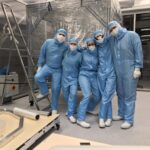
Assembling the XENONnT Dark Matter Detector during Covid-19 Times
The nature of dark matter (DM), an invisible substance which constitutes 85% of matter in the observable universe, is one of the greatest puzzles in cosmology and astroparticle physics today. The most compelling and simplest solution is that DM is made of a new type of fundamental particle, not yet observed due to its incredibly feeble interaction with visible matter. The XENON collaboration produced world-leading results in the hunt for dark matter with the XENON1T detector and was just beginning to assemble the upgrade, XENONnT, when Covid-19 hit the world. This article describes the remarkable work done by some members of the collaboration to build XENONnT during Covid-19 times.
The XENON collaboration, a group of about 160 scientists from Europe, the USA and Asia, builds ultra-sensitive detectors with the aim of observing particle DM via scatters with atomic nuclei or electrons in a large volume of liquid xenon, kept cold at -95 °C. These detectors are based on the two-phase time projection chamber (TPC) technique, where the tiny light and charge signals released when a particle crosses the detector is observed. The measurement of the deposited energy and of the interaction position allows for the rejection of the majority of background events from radioactivity, maximizing the chance of observing ultra-rare interactions as predicted from DM.
The latest experiment in the XENON family was XENON1T, which operated 3.2 tons of liquid xenon in total, with 2 tons viewed by two arrays of photomultiplier tubes (PMTs), until the end of 2018 at the Laboratori Nazionali del Gran Sasso (LNGS) of INFN in Italy. This experiment reached the lowest background ever observed in a direct DM detection experiment, and set the strongest constraints on the interaction cross section of DM particles with nucleons above particle masses of about 85 MeV/c2 [PRL 121, 2018, PRL 123, 2019]. It also observed for the first time the two neutrino double electron capture process in 124-Xe with a half-life of 1.8 x 1022 years – the slowest process ever observed directly [Nature, Volume 568, April 2019]. Recently XENON1T reported an exciting excess of events in the low-energy region, which might be due to Tritium beta-decays, but could also be a hint for solar axions or other new physics beyond the Standard Model.
The XENONnT detector is an upgrade to XENON1T, with an increase of the active mass by a factor of three (8.3 tons of liquid xenon in total, with 5.9 tons in the TPC). While XENONnT will utilise much of the infrastructure built for XENON1T, it will operate a new TPC equipped with 494 PMTs and a neutron veto (based on Gd-loaded water) contained within the existing water Cherenkov muon veto. It will also feature a new liquid xenon purification system, as well as a radon distillation column, among other vital sub-systems.
The assembly during this challenging times was only possible due to the excellent management of the crisis and the support by LNGS, especially it’s director, Prof. Stefano Ragazzi and other members of the laboratory. The LNGS director imposed at all times very adequate and reasonable rules to minimize risks, following the general evolution of the crisis. This included adequately growing access restrictions and very strict rules for any work to be performed. The XENON collaboration followed these rules very carefully and asked over some time daily for permission of very careful chosen next steps, performed by a team of decreasing size.
Covid-19 started in December 2019 in Wuhan, China, and it seemed very far away and not relevant. On February 21 first cases were detected in the Milano area and the Italian government implemented red zones in the Lombardy region and in the Veneto area already on February 22. When the first Covid-19 cases appeared in Italy in mid February 2020, the TPC crew at LNGS was close to start assembling the detector components in a clean room (CR) above ground. The assembly work started February 24, and was completed in record time, about a week later.
On March 3, Bergamo became a red zone, expanded on March 7 to a large part of northern Italy and on March 10 to all of Italy. Within a rather short time life had changed drastically including life and work at LNGS. On March 5, the carefully packaged TPC was transported to the underground (UG) site with a dedicated low-vibration truck and an experienced driver. The goal was to minimize vibrations as much as possible during the short but potentially dangerous journey. On March 8 it was announced that only LNGS personnel will be allowed to access the above ground facilities. The Covid-19 related lockdown in Italy was issued on March 9. UG work was also strongly restricted to essential or urgent operations starting on March 10. The XENON collaboration performed in this phase well prepared steps involving a decreasing number of people who stayed at LNGS. From some moment on all steps were reviewed and approved by the LNGS director on a daily basis. Nonetheless, the work UG continued, for the TPC had to be inserted in the inner cryostat vessel, cabled and connected to the cryogenic systems, flushed with gaseous nitrogen to reduce radon plate-out etc. All these delicate operations and the following initial detector commissioning could be successfully completed with the help of a small group of people who was willing to work very flexible under very special conditions.
On March 20 first Covid-19 cases were found in Paganica close to LNGS where a number of the XENON team members were living. Some group members left at this time as planned. Others stayed even though their group leaders asked them to leave LNGS if they feel uneasy or endangered. A number of them stayed and carefully minimized risk as much as possible. The XENON collaboration owes all of those who worked under these conditions a lot and it is to a large extend their achievement that we have now a detector which is already in commissioning phase. Currently – as of summer 2020 – the XENONnT detector is well under commissioning at LNGS – with first light being observed in the gaseous xenon phase and full operation expected in the next months.
In the following, members of this team describe this challenging and stressful experience. Due to their dedication and willingness to remain on site while most others left, the XENONnT TPC was successfully installed UG, the necessary tests completed and the commissioning phase could start. This allowed the collaboration to see first light in the PMT arrays only a few weeks later. It is very interesting to hear the stories from some of these team members, since this shows the growing restrictions, the dedication of the team members, the adjustments necessary to complete such an operation in the very challenging Covid-19 situation.
CHIARA CAPELLI (PhD, UZH) – Assembly of the TPC
February 24 (and before) to March 5
I came to LNGS around the middle of February, to start preparing the components I had to take care and to participate in the assembly of the TPC. It was a moment of general excitement. Finally after intensive months (actually years) the collaboration was ready to start assembling the XENONnT detector. All the pieces had been designed and the required materials had been selected, manufactured and cleaned, in a process involving many research groups, and lots of people, around the world. In order to construct an experiment to search for an extremely rare interaction, any radioactive isotope (that may produce an interaction and thus mimic the shape of the signal we are looking for) has to be avoided. For this reason, all the TPC components have been shipped to LNGS where people like Stefan Bruenner (Postdoc, MPIK/Nikhef), Arianna Rocchetti (PhD, Freiburg), Jacques Pienaar (Postdoc, Chicago) and Junji Naganoma (researcher, LNGS) among many others, take care of cleaning and storing all components in air controlled environments before being installed. Despite how easy this may sound, this is an incredible difficult task. Each material and each component has to be treated in a unique manner, and it requires an incredible organizational effort and an even larger manpower availability. It is definitely not what people usually imagine a physicist job is 😉
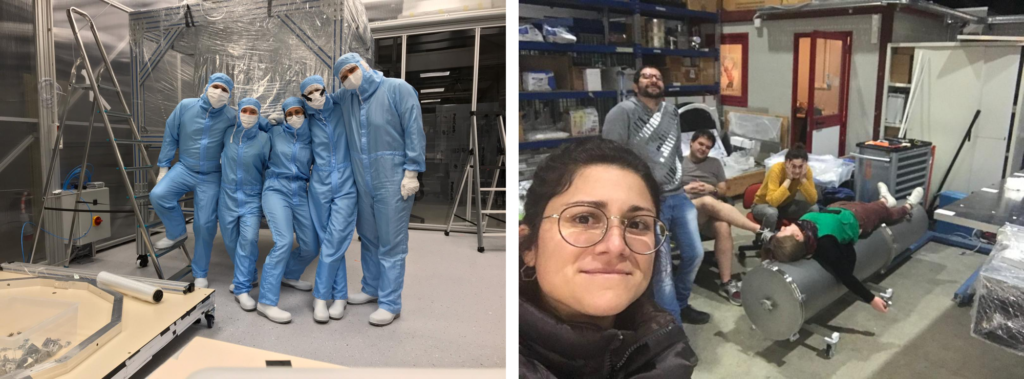
The Wednesday night team, 4th March, the day before TPC transportation: in the cleanroom as soon as the TPC was ready and bagged to go UG (left) and afterward outside the cleanroom (right). Right picture from the left, Arianna Rocchetti (Freiburg), Riccardo Biondi (Aquila U.), Jacques Pienaar (UChicago), Chiara Capelli (Zurich) and Luisa Hötzsch (MPIK).
In my case, I came to LNGS to install optical fibers, used for internal light PMT calibration. When I arrived at the airport in Rome there was a queue for letting people in after a thermal body-scan. I remember there was already the news of a virus spreading in China and a few cases around the world but I didn’t think it could affect us in such a way, and definitely I couldn’t imagine the whole Europe under lockdown. I was lucky enough (or not, depending on how you want to see it) to also help in several other tasks (i.e., built the main structure of the TPC, screw the internal reflective PTFE panels, and fix the field shaping copper wires and rings around the TPC). We were all working very hard those days, where we frequently skipped lunch and worked until late night. We finished installing the fibers on Sunday night, March 1st and transportation of the assembled TPC to the underground facilities of the laboratory had been scheduled for next Thursday, March 5th, where still several things had to be done before.
I clearly remember Wednesday, March 4th. There were still quite few things to do in a day, so we started early. In order to work in an air controlled environment, we needed to be inside a clean-room (CR). Working in a CR can be fascinating the first 15 minutes, just the time to start sweating in the suit and breathing badly behind the mask. Taking breaks is also annoying as it means you have to follow the procedure to undress and dress again in a safe way (safe=clean). That evening we knew we couldn’t go home until the TPC was closed in a protective bag ready to be transported. It was getting late, we were all extremely tired and starting to get nervous. As in real life, building the most sensitive detector is not always a love story, and we encountered several problems we had to overcome (I understand now the famous “problem solving” skills we tend to claim on our CVs…). Despite all and everything, we managed it! In fact, we never considered any other possibility but succeeding! 😀
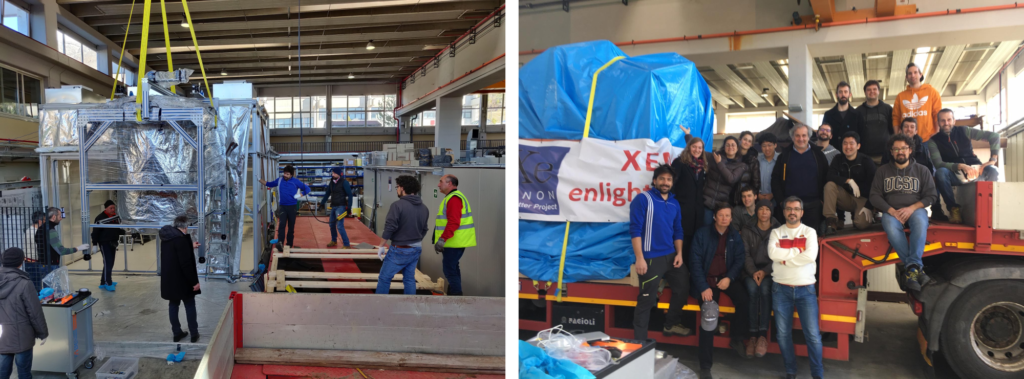
Part of the XENONnT crew next to the assembled TPC, properly bagged for the transportation underground. Right picture from the left: bottom row, Danilo Tatananni (LNGS), Petr Shagin (Rice), Adam Brown (Zurich), Junji Naganoma (LNGS), Luca Grandi (Chicago); middle row, Luisa Hötzsch (MPIK), Arianna Rocchetti (Freiburg), Chiara Capelli (Zurich), Yu-Chin Chen (Tokyo), Marcello Messina (LNGS), Riccardo Biondi (Aquila U.), Masatoshi Kobayashi (Kamioka-Columbia), Francesco Lombardi (Coimbra), Giovanni Volta (Zurich), Roberto Corrieri (LNGS); top row Shayne Reichard (Zurich) , Jacques Pienaar (UChicago), Michael Murra (Münster).
GIOVANNI VOLTA (UZH) – Cabling operation and underground TPC operation
March 4 to March 13
Adam Bown (UZH) and I left from Zurich towards LNGS the afternoon of March 4th. The Coronavirus spread was still localized in Lombardy, but worry had already started spreading everywhere: the plane was almost empty and everyone was a bit sceptical. At that point, I must admit I was not worried at all, I tended to believe that everything was an exaggerated reaction. That same evening, when arriving to LNGS, we went directly UG (TPC transportation had already been scheduled for next morning, and cable test had to be finished beforehand). We tested the electrical connection of almost 15 km of cables, going from the XENON facility building to inside the water-tank where the TPC is connected). Moreover, cables had to be sorted and organized from the water tank side, for the TPC arrival. We worked all night long, where our own excitement kept us awake (our main goal was close to be achieved and, then, all our efforts potentially rewarded). It is difficult to give credit to all the people that had contributed to this effort, but to list a few, at least, Alessandro Manfredini (UZH) and Josè Cuenca (KIT).
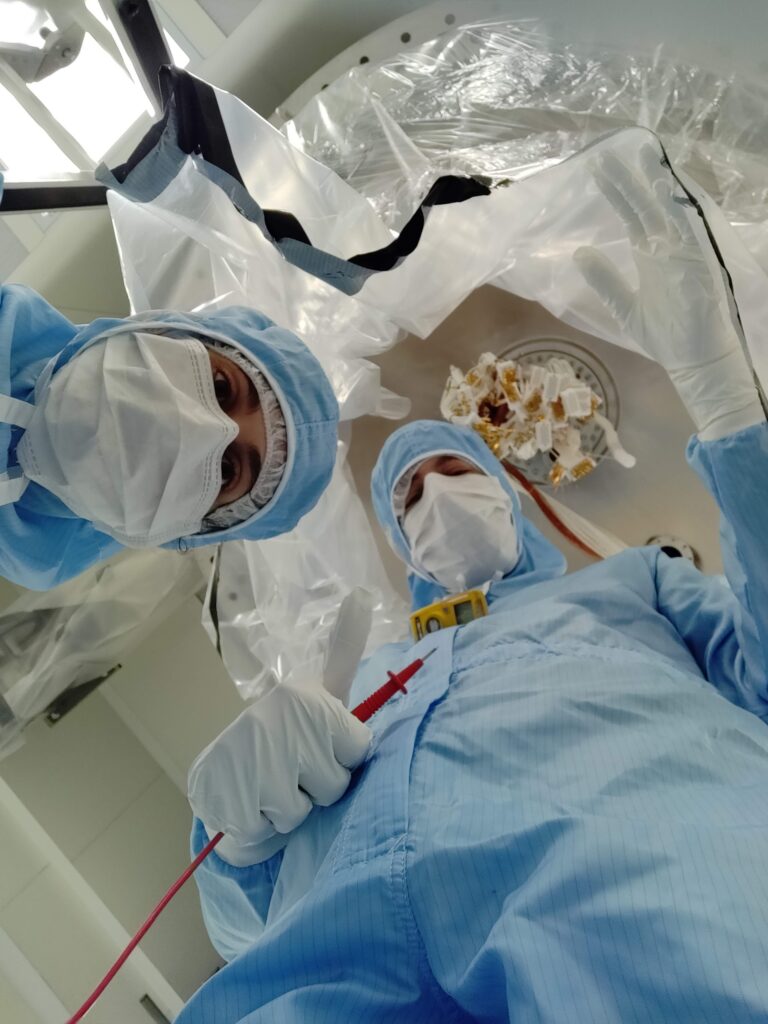
Chiara Capelli and Giovanni Volta inside the clean room underground, inside the water tank, during the cable testing inside the water tank.
Transportation went smooth and, by the end of the week, TPC had been successfully lifted and installed under the XENONnT dome, everything enclosed into another clean room UG. This was already a great achievement and, in order to celebrate it, we organized a dinner the evening of Friday 6th. This was the day everything changed, where all north Italy was declared a red zone, Coronavirus cases were being found everywhere, and regulations around Italy and the rest of the world were getting more restrictive on a daily basis. I guess we all got a bit scared, scared about the virus, scared about not being able to go home, and… also scared about XENONnT and our TPC that was not properly protected yet…
In order to have our TPC safe from contaminants, we wanted to lift and close the XENONnT inner vessel (a stainless steel cryostat that would enclose the whole TPC and the cryogenic instrumentation of XENONnT could reduce the air concentration within the TPC by over 10 orders of magnitude with respect to ambient air concentration). Just few seconds of exposure to normal air would throw away all the work done, with potentially irreversible consequences. There is no easy way back after having closed the inner-cryostat, and hence many things had to be connected and tested beforehand, in order to give green light to proceed. I believe that it was around this point when we started realizing that our health could also be compromised, and despite a rational decision would have been to quit, we didn’t give up. We cared too much about this experiment, and we had invested too much time and effort on it to let it go without fighting. The situation at the lab (and on Earth) was so uncertain that it was unclear what the next day could happen or when something/someone would block us.We wanted to give it a try, at least. Now looking backwards, one sees how lucky we were in some aspects, but definitely, what made the difference is how prepared we were for that moment. We had been working hard to get here, and all this preparation and knowledge allowed us to solve problems and make progress under the most adverse circumstances, until finally lifting and closing the inner cryostat.
I’ve been thinking about it since then, now that a few weeks have already passed and after all the great feedback we got from our colleagues and bosses. It is not that I have a super clear opinion about it, but I do know that we were not heros nor brave. Instead, I tend to think we were more kind of foolish and irresponsible people. We really care about what we do and, it is especially during these hard days of group work, where everyone is pushing towards the same directions, where things get really intense and emotional. We, as most of us did, underestimated the impact of Coronavirus and luckily, we have nothing to regret about now. After evaluating the general situation (health care, personal situation and governmental indications), some of us decided to remain isolated at the lab, and wait for things to improve. Having closed the inner-cryostat may look like a simple action, not worth taking all this risk for it, but it may also very well be that with our effort, we managed to deliver an instrument that may change our understanding of Nature for days to come.
Joaquim Palacio (Subatech-MPIK) – Xenon storage responsible
March 9 to March 13
Friday March 13 was the day we managed to lift the inner cryostat, finally closing the XENONnT TPC into a controlled environment. I remember it was sometime in the afternoon (being UG, is very difficult to keep track of the time, since there is no light change during sunset or sunrise) and I was inside the XENONnT water tank, ready for the operation of lifting the inner cryostat, waiting for instructions from our colleagues inside the underground CR (literally on top of us). The lifting operation, by itself, is not long nor complicated. The main problem is getting ready for it. Weeks of work and maintenance operations are needed in order to get all the areas and tools ready, which reduces the chances of contaminating the TPC with any external background, which would be fatal for the lifetime of the experiment. Even in terms of manpower, getting properly dressed takes a few minutes and then, the stupidest operation (i.e., going to the toilet) becomes a small nightmare. I remember the cold of that moment, the sound of air blowing from the air system, the tension on everyone. I was absolutely exhausted. The rhythm of the last weeks and months had been increasingly high, culminating in that week that was about to finish (and the COVID situation had not made things easier).
I must admit that on the previous Monday, March 9, I was still laughing at all this virus situation. It is true that the general atmosphere at the lab had changed quite a lot, but I was still quite reluctant about the whole panic. It was around Tuesday 10th, when Luca Grandi (the responsible of the TPC integration) informed all of us that all Italy had become a single red zone (what meant that COVID restrictions now applied to all Italy in the same way). It was weird to realize that individual freedom had suddenly changed, and we were not allowed to go out any more. My first 2 thoughts were whether I should tell my family (living in Barcelona) and whether I should go shopping the very next day (fearing that there could be some sort of food shortage). I did none of the two, as I was trying to contribute the least to the general panic spread.
Next morning, Wednesday, March 11, we all met at the laboratory as we were every morning doing. That morning everyone was particularly quieter, more than usual. We all showed up wearing masks and gloves (we have easy access to this kind of equipment, as it is commonly used in all our CRs). We were told by Luca Grandi that bars and restaurants had been closed, and that soon after, hotels would do so as well (what would be a problem for several of us, temporarily staying in a Hotel close to the lab). He also encouraged us to go shopping that same morning, if needed, since the day was expected to be long and would presumably finish late enough such that stores would be already closed. I guess that was the first day people started showing some concerns and/or fear about the whole COVID thing. There was no huge discussion about it, on the contrary, people remained rather quiet. I guess most of us were willing to continue, to pursue further, but foreign people being abroad on a trip to LNGS, started to be concerned on their way back.
Thursday, March 12 in the morning was already like living in a different world. The lab was absolutely empty. I stayed above ground all morning (had been UG for the last days) waiting for news from the people working in the underground CR. It was a sunny, warm and beautiful day, but it was easy to grasp people’s concerns in their faces. I was in my office, waiting with Roberto Corrieri (the XENONnT GLIMOS – our safety officer) and Mike Clark (Purdue U.), where we were just waiting for instructions from people UG. I had the feeling that Roberto had been in a bad mood all the previous week. It was then, after seeing how things had developed internationally, I understood better what Roberto had been going through the past days. I realised then that none of us, but Roberto, had understood by then what was going on, and what was about to come. Roberto had been following the news for the last few weeks, and as an Italian, as the XENON GLIMOS but, mostly, as our friend, he was definitely worried about all of us. It was in his XENON role to protect us, but he was doing more than that.

Picture of the XENONnT inner cryostat closed. Underground CR has been already removed and reflective water tank walls are visible all around.
Friday march 13 I had woken up at 3:00 am, and drove Mike Clark and Michael Murra (Muenster U) to the Airport. Both had booked their flight ticket the day before. It is about 1 hour and 30 minutes drive, and you need to drive all around Rome, however, the highway was absolutely empty. We barely talked on the way there and the airport was full of police and military men.
Coming back on Friday afternoon, inside the water tank and right below the CR… I could hear Danilo Tatananni’s (cryogenic expert LNGS) voice, however not loud enough to understand what he was saying. Danilo is our cryogenic expert, he is BY FAR the most skilled person to operate and manipulate the XENONnT detector. Any installation, maintenance or modification of the system is supervised by Danilo, and the TPC installation was not an exception. So here I was, a Friday afternoon UG, dressed on a clean suit, after having slept 3 hours, hearing Danilo’s voice giving instructions to the rest of the members inside the CR, and waiting for Danilo’s green light to lift the inner vessel, where I suddenly felt incredibly tired (all the accumulated stress from the previous days came suddenly over me). My eyes were closing against my will and I decided to have some sleep assuming I would be woken up when operation should start. It is DEFINITELY NOT within cleanliness standards to touch with your clean suit any floor or wall, as you may be contaminating your suit however, since I was not supposed to work next to the TPC, I decided to bend over that rule and crushed a few minutes sitting on the structure supporting the inner cryostat (that was still waiting to be lifted).
After the operation was finished, one of the people I was willing to inform first was Stefan Brünner (Nihkef), an expert on gas purity on ultra-low radioactive environments. Over the last 12 months, Stefan had been pushing the limits of his own, and the rest of the XENON team, to achieve the lowest impurity level for the XENONnT detector. Removing traces of contaminants is not a simple task. You cannot clean a ~200 kg TPC all at once. Not only the optimal materials had been selected over the last 5 years, but over the last 12 months, each of the individual components had been treated, cleaned, and accordingly stored until the assembly. TPC had been successfully assembled nearly 2 weeks ago, but this didn’t mean his concerns were over since air exposure was still a potential danger. I guess that if someone finally had some rest that night, after closing the inner vessel, it had to be Stefan.
Danilo Tatananni (LNGS) – XENONnT cryogenic work
March 14 to April 12
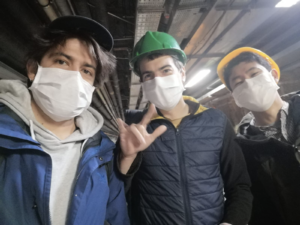
Picture of the 3 XENON members UG during the Italian lock down. From left to right: Danilo Tatananni (LNGS), Joaquim Palacio (MPIK) and Masatoshi Kobayashi (Columbia).
The days to come after the inner cryostat was closed were much easier, as for the first time over the last weeks time was not against us. News of COVID cases around l’Aquila were reported and the collaboration gave clear instructions to leave the laboratory. We had some chatting among us, the XENON members present at LNGS, and we encouraged all foreign members present at LNGS to return home and only ‘local’ people (living at driving distance from the lab, as is my case) should remain. For this next phase of the experiment, I was closely working with Masatoshi Kobayashi, a Japanese colleague expert on cryogenics that did his PhD in the Kamioka Laboratory and is now at Columbia University. Masa had been at LNGS for the last 7 months, and kept working on the TPC assembling and installation until inner cryostat was closed. Masa had decided to stay at LNGS during the pandemia spread, and it was only after Japan authorities made public they planned to close Japan borders, Masa started to consider to return to Japan. During the days to come, we followed and periodically analyzed the evolution of the instrument while being in very strong vacuum conditions. The evolution of the residual gasses released during these first days under vacuum tell us about the properties of the TPC. First gasses to be released come from the surfaces for the components of the TPC were, as days goes on, gasses trapped within the pores from the bulk of materials are released (it is like reconstructing backwards the assembly history of the TPC, and being able to evaluate the successfulness of the work done during the last year). I had the impression it was very hard for Masa to make up his mind, as a compromise between his care for the experiment and his colleagues, international health care advice not to spread further the virus, and of course personal matters related to his family. Needless to say, we all supported the idea that Masa should go home, and on Friday, March 27, he flew to Japan (the day before Japan authorities would actually close the border). He was stuck for 48 hours at Tokyo’s airport and was tested negative of COVID19. He still stayed locked down into the closest hotel room to his parents place before he finally joined his family. Funnily enough, collaborations between Japan and Europe are rather good, since work/sleep time is easily adjustable to provide 24h coverage on the experiment. Masatoshi and I kept interacting on a daily basis until April 12, where his availability on internet rapidly dropped (probably due to bad internet connection at his parents place…).
These impressions by members of the team which assembled XENONnT during the peak of the Covid-19 crisis show how difficult and challenging the work was. “The completed XENONnT detector will now allow us to soon probe exciting new territory where we might see dark matter or other new physics”, says Laura Baudis, (UZH), one of the leading members of XENON. Manfred Lindner, (MPIK), Co-Spokesperson of the XENON Collaboration, adds “XENONnT tests the most plausible parameter space where WIMPs, top candidates for the Dark Matter, could be found. The collaboration is very grateful to the team which assembled XENONnT during these difficult times. They put us into a leading position in the race towards understanding what dark matter is”.



